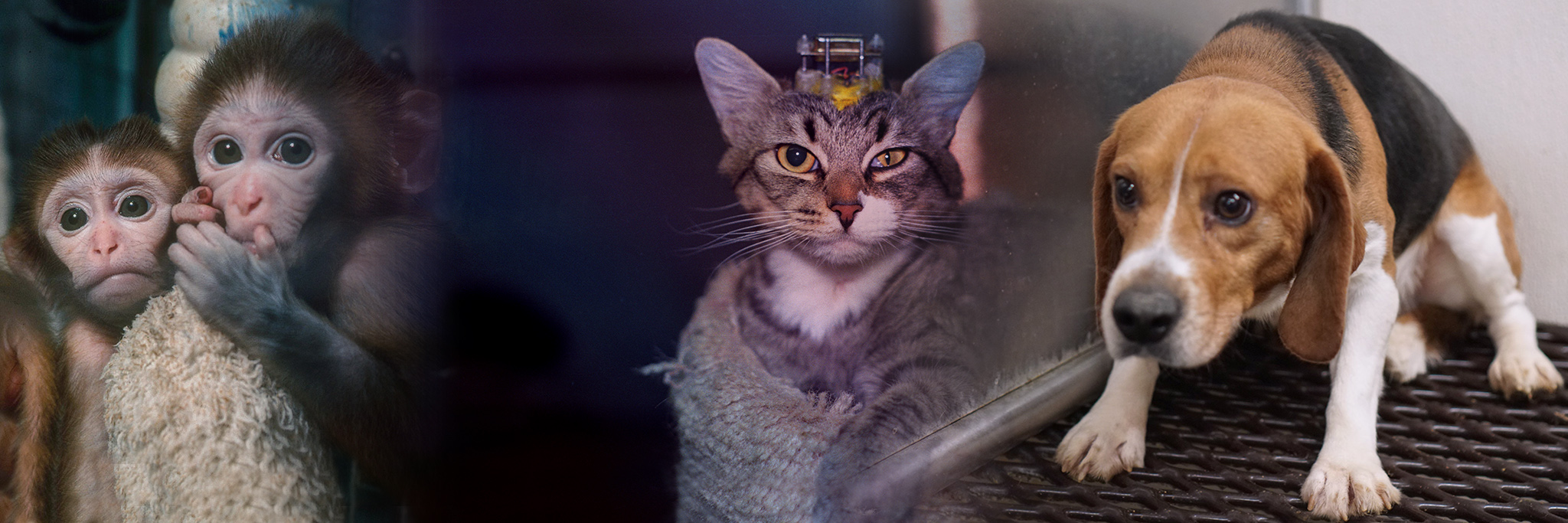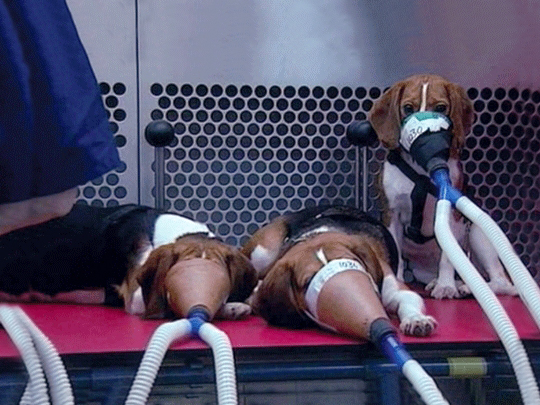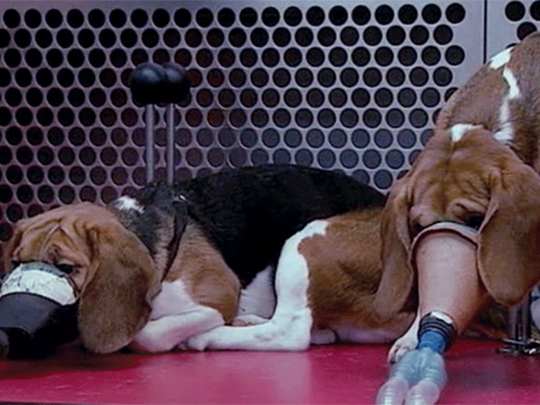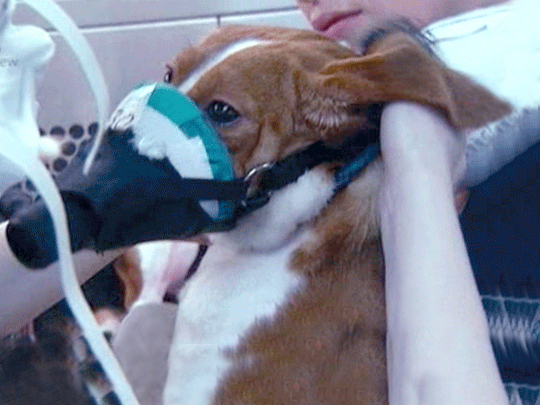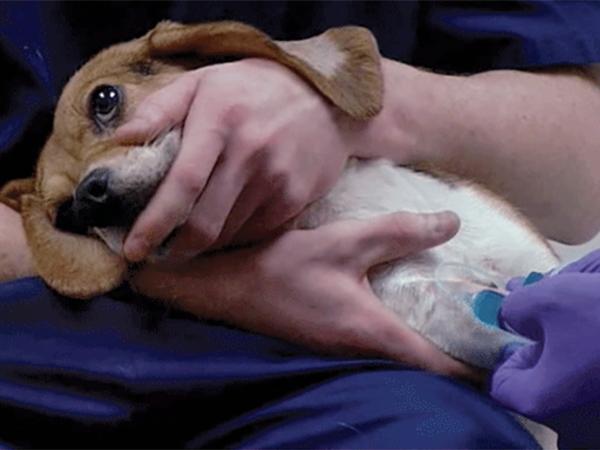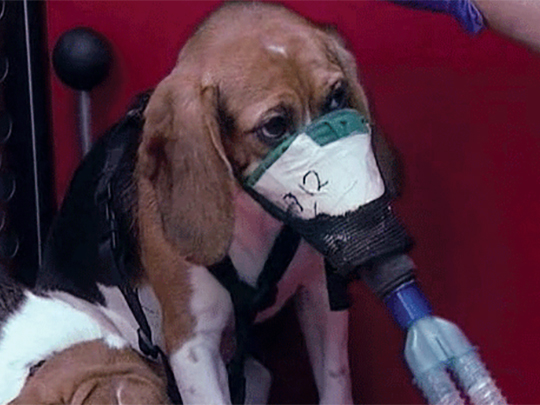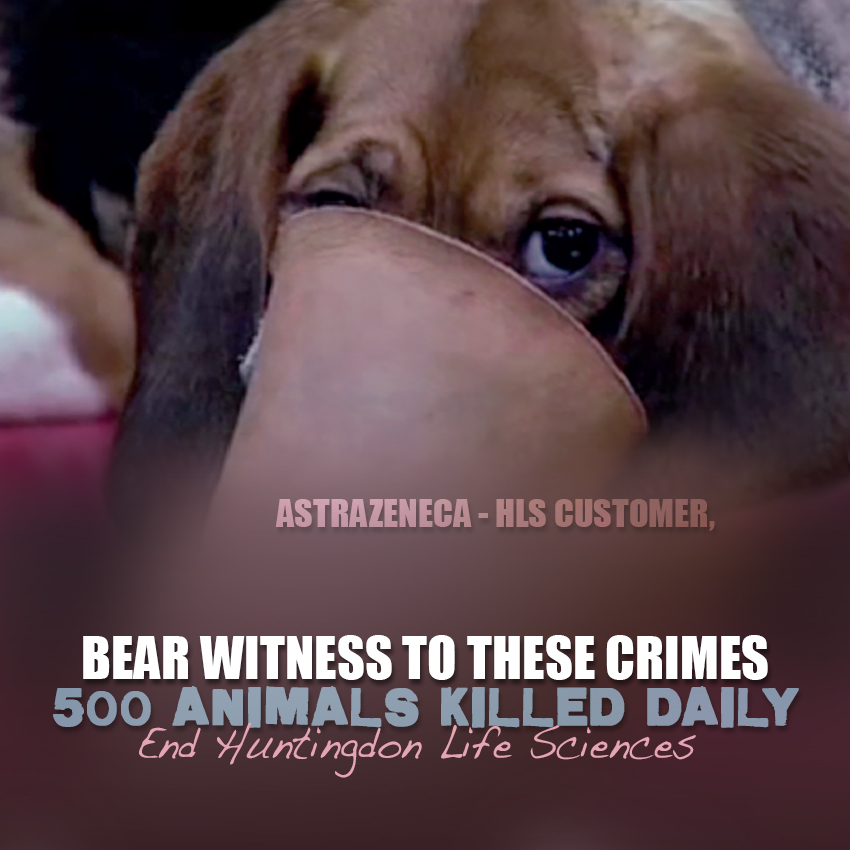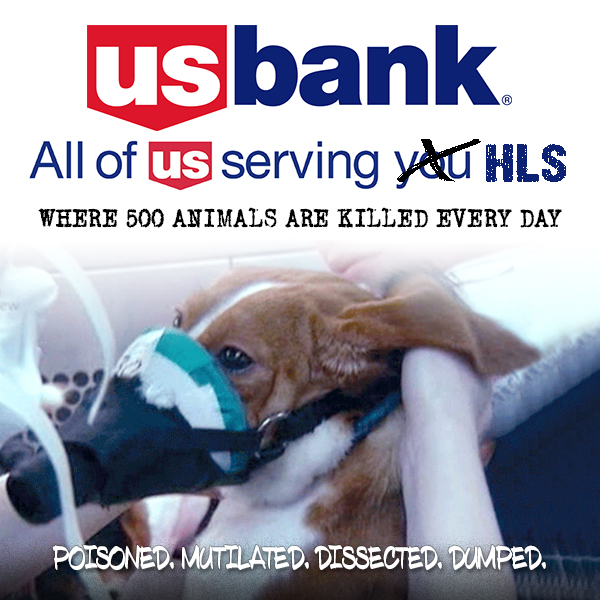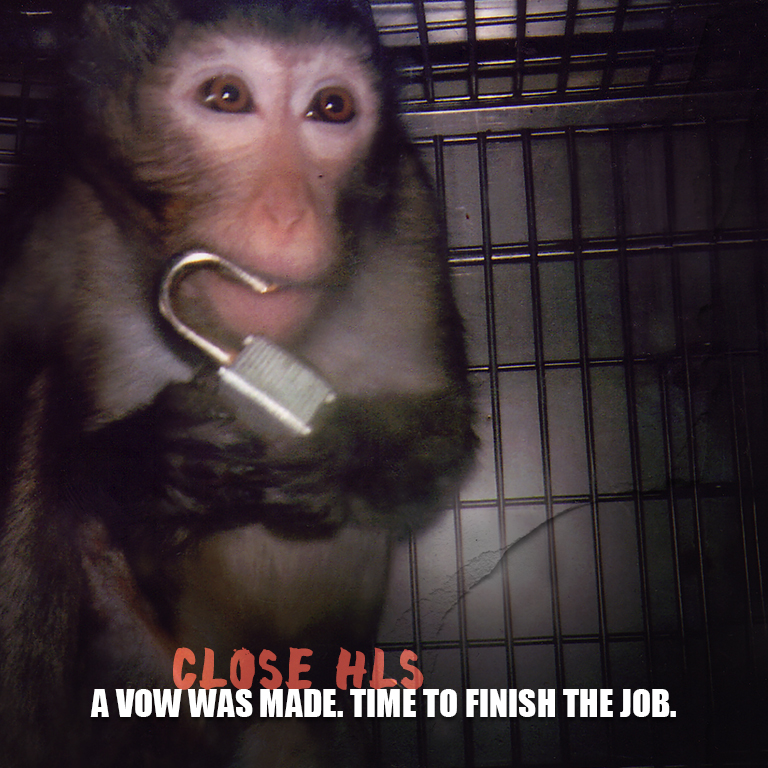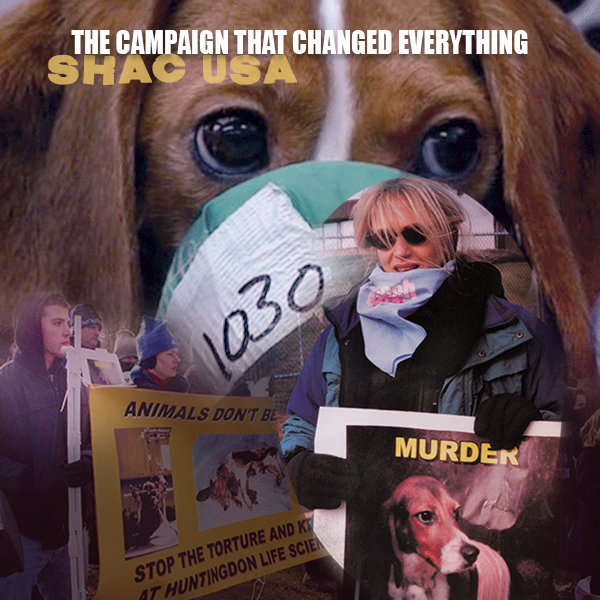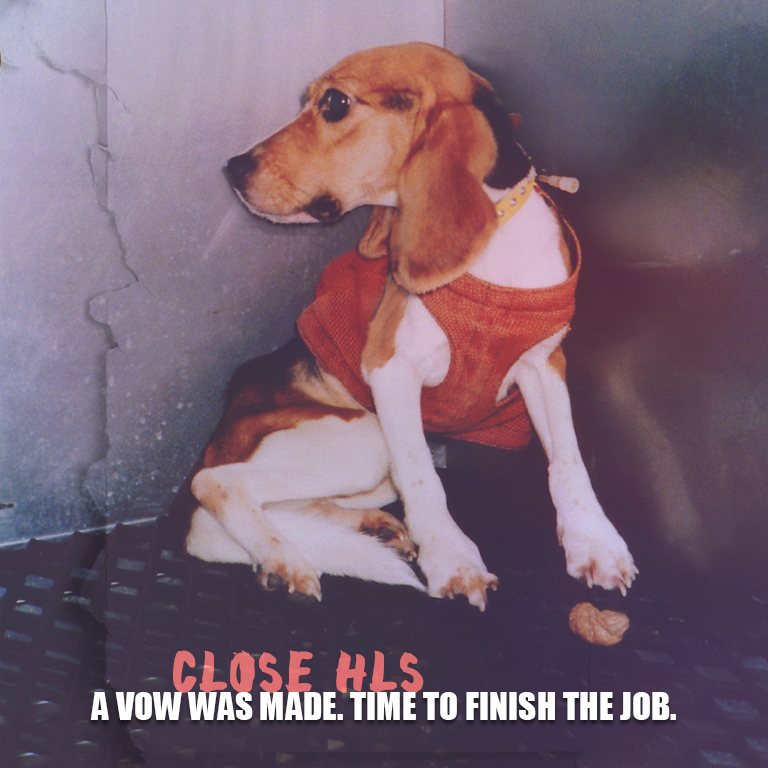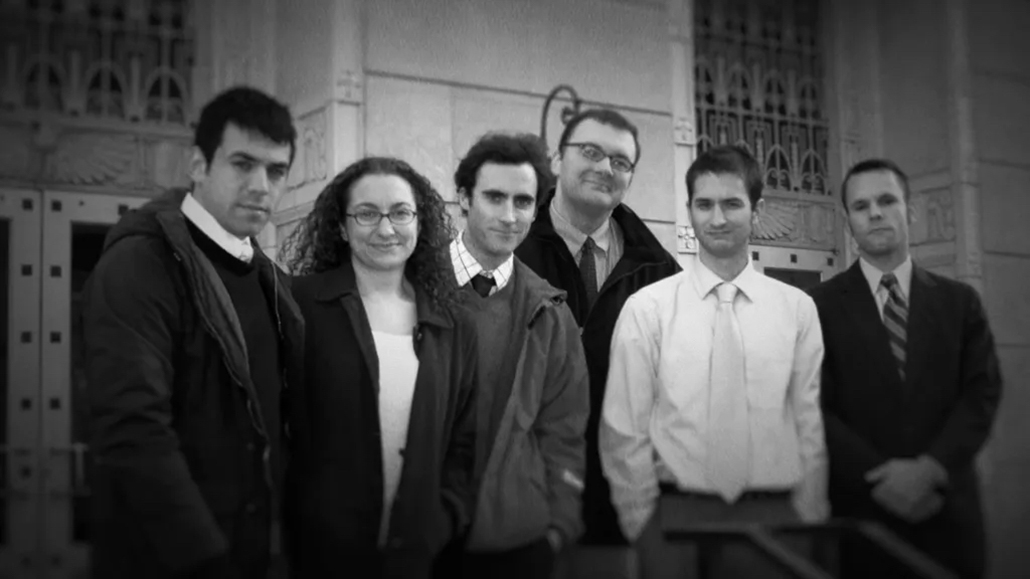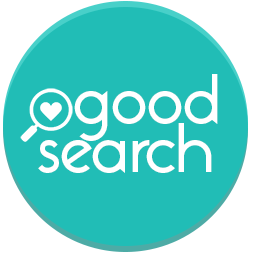huntingdon life sciences
I'm sick. Hot and cold. Shaking. The first time I see a lab tech grab the little beagle by the loose skin over his neck. As the pup's legs frantically peddle air, the tech draws back his fist and punches the dog over and over. I scream inside, still.
SHAC-USA Weekend Of Action On HLS 50th Birthday
Speaker Brenda Shoss, Kinship Circle
Rod Coronado, Animal Liberation Front volunteer
Chris DeRose, Last Chance for Animals
Robin Webb, UK Animal Liberation Front spokesperson
Bobby Seale, Black Panthers founding chairman
SHAC-USA leaders Kevin Kjonaas, Jake Conroy, Lauren Gazzola, Josh Harper, Andy Stepanian, Darius Fullmer
Welcome to Huntingdon Life Sciences, where an average 500 animals are killed daily to test GMOs, pesticides, fertilizers, household goods, drugs, diet pills, additives, sweeteners… The lab has incurred: U.S. Animal Welfare Act violations, arrest of personnel on cruelty charges, more than 600 infringements of Good Laboratory Practice Laws in England, and payoffs to the U.S. Agriculture Department for fraudulent records and animal welfare offenses. Investigations from 1997 through 2012 establish egregious animal abuse as the the “daily normal” at HLS. Huntingdon confines dogs, cats, monkeys, birds, rabbits, mice, pigs…
Routine violence includes the scene of a lab tech punching a beagle puppy, filmed by UK Channel 4 TV. Inept techs kill dogs by flooding their lungs with toxins meant for their stomachs. A convulsing monkey's chest is cut open in a supposedly post-mortem dissection. Dogs are insufficiently anesthetized before painful bone marrow extraction. Monkeys, strapped in restraint chairs, are so terrified some suffer rectal prolapse. During forced inhalation tests, monkeys die in agony from collapsed or obstructed lungs…
Despite credible evidence, pharma czars like AstraZeneca still hire Huntingdon Life Sciences to test their medical products. While other HLS customers, suppliers and financiers have dumped the lab, AstraZeneca has sent about 300 Beagles from their (now closed) breeding farm in Sweden to HLS. Ask AstraZeneca to: Release the Beagles for adoption and end business with HLS. Share the evidence so AZ can make an informed decision about who they do business with.
Editorial UpdateStop Huntingdon Animal Cruelty (SHAC-UK/US) groups are now gone, victims of government suppression on behalf of HLS and Big Pharma, plus the institutionalization of animal torture as science. Where is HLS today? First, HLS re-brands as Life Sciences Research Inc. Then they merge with Harlan Laboratories to become the Envigo brand. By 2021, HLS is absorbed into a power nexus of animal experimenters under the banner Inotiv. There is scant trace of HLS online. But animal advocates will find them again. They always do.
Huntingdon Life Sciences
Huntingdon Life Sciences
Huntingdon Life Sciences
HISTORY OF VIOLENCE
Caught: On Camera, Testimony, Record. Profound animal abuse is exposed in multiple investigations that span more than a decade. Huntingdon Life Sciences is a global giant in animal research, with labs in England and New Jersey, USA. About 180,000 animals are annually poisoned, killed and dissected to test GMOs, pesticides, fertilizers, household goods, drugs, diet pills, additives, sweeteners… Dogs, cats, monkeys, rabbits, pigs, mice and more animals are overdosed via nasal-gastric tube, inhalation and injection. Relentlessly needle-jabbed and surgically maimed, some 500 animals die each day. HLS is cited for: U.S. Animal Welfare Act violations, arrest of personnel on cruelty charges, more than 600 infringements of Good Laboratory Practice Laws in England, and payoffs to the U.S. Agriculture Dept. for fraudulent records and animal welfare offenses. Since 1997, leaked internal documents, staff affidavits and undercover film show pathological cruelty.
Bad Science. In recent decades, biotechnology has evolved with breakthroughs in species-focused cellular, genomic and computational tools. These human-focused experiments mean researchers don't need to extrapolate info from animals to people. The science is more predictive, rather than assumptive. To call animal-free research an alternative implies that animal experiments are the gold standard. In fact, human-based science is more expedient and replicable, with data related to human conditions. Conversely, data from animals artificially induced with human disease and injury is deceptive. Labs like HLS systemically inflict pain for tests “only reliable 5-25% of the time,” as one HLS record contends.
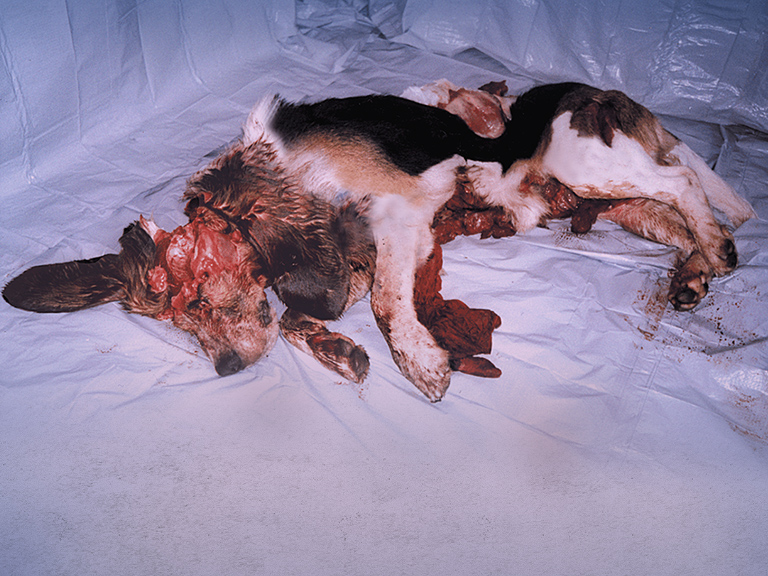
1997HLS Beagle Unit. Zoe Broughton works covertly in the HLS Beagle Unit for Countryside Undercover, a UK Channel Four TV series. She sees listless dogs in cement cages and Home Office Inspectors who fail to check animals while on site. Dogs injected with a liver-scan chemical (already approved for human use) grow sick, with swollen and movement-impaired legs. If they squirm during painful blood draws, workers become angry and impatient: “A worker swung a puppy by the scruff of her neck, swore, shouted and continually punched her as she screamed.” The beagle punching incident is caught on camera, infamous footage that sparks a movement to shut down HLS.
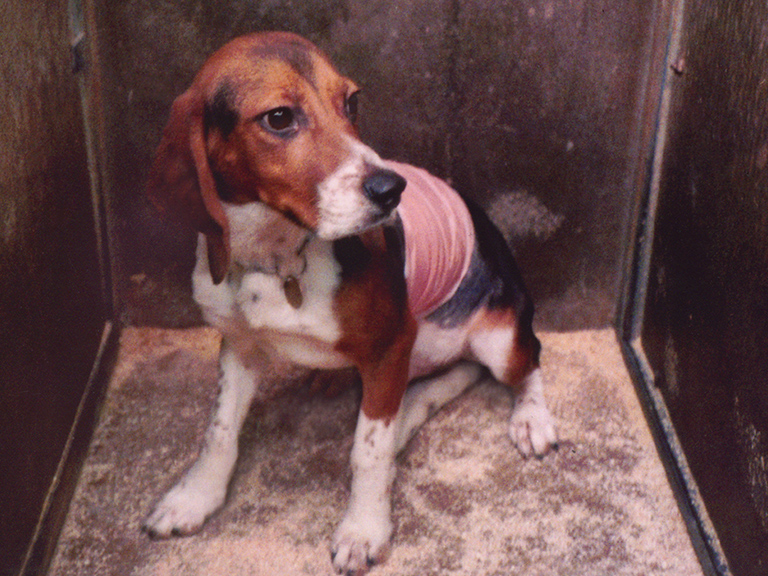
1997-2001Diary Of Despair. Michelle Rokke records ruthless abuse while undercover for PETA at Huntingdon Life Sciences. Animals vomit, drool, stagger, seize, collapse. Techs kill dogs by flooding their lungs with toxins meant for their stomachs. During a supposedly post-mortem exam, a tech cuts open the chest of a convulsing monkey. In another necropsy, “a vivisector knifes into a [presumed dead] Beagle. The dog throws his head back. His last howls occur as leg muscles are severed.” Techs joke over a restrained monkey, “I'm sure the sponsor will love that.” Another says “Bring up their heartbeats a little bit more” as a third blurts, “You can wipe your ass on that data.”
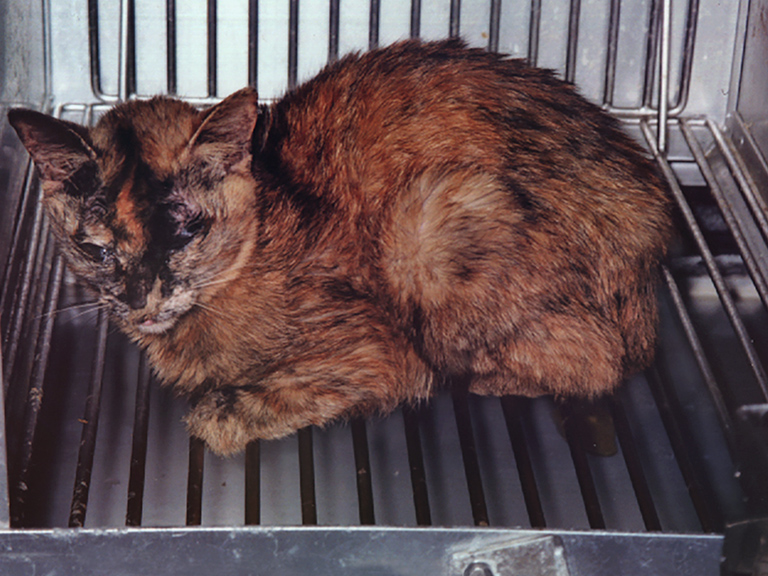
2000Drunk Science. Records from HLS Eye Research Centre in Suffolk, UK reveal that staff consume alcohol and drugs at work. A worker jokingly recounts an escaped baboon's dash across a busy thoroughfare. A male marmoset is killed after his leg is irreversibly fractured in the “gangcage.” The margin of error is wide when animal testers are inebriated.
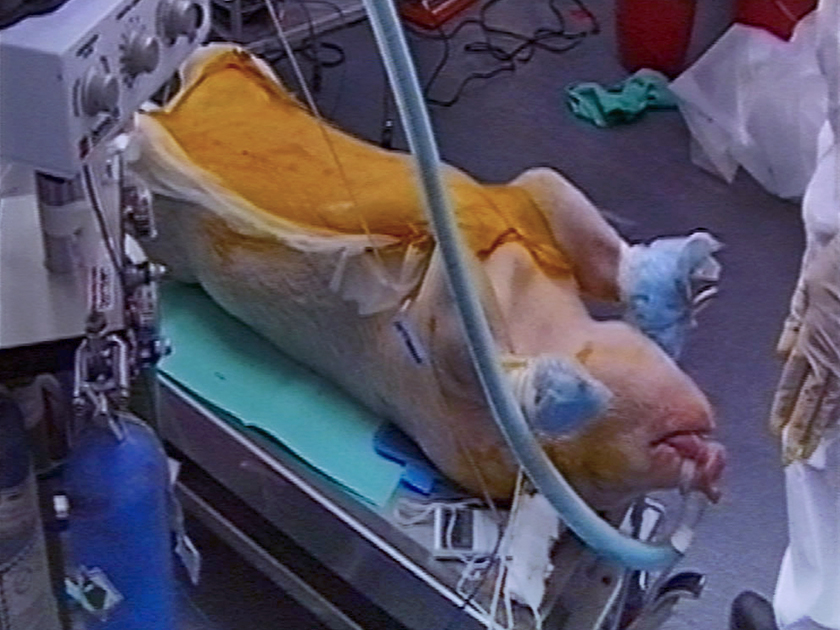
2000 – 2003Horror Show. Internal documents leaked to Uncaged Campaigns disclose grossly incompetent HLS xenotransplantation tests. Genetically engineered organs are harvested in pigs. Their hearts are extracted to stitch to the necks of hundreds of monkeys. Primates suffer diarrhea, vomiting, oozing wounds, seizures. They're seen “screaming, reluctant to move, salivating, huddled with severe tremors on torso and head, collapsing, labored breathing.” After death from mass organ rejection and hemorrhage, sponsor Novartis cancels the invalid tests and files an injunction to ban public knowledge (later overturned).
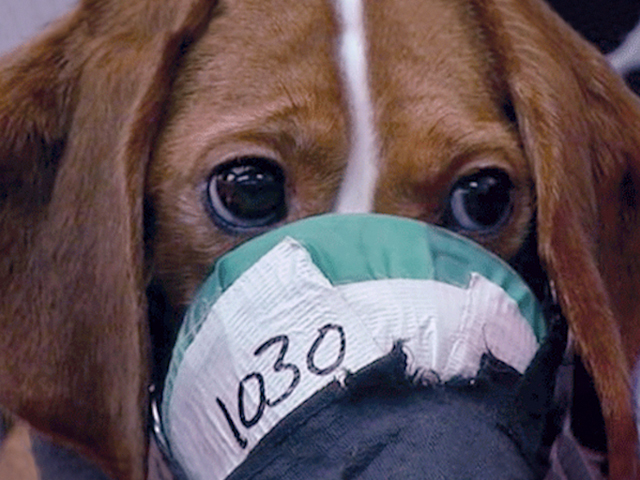
2004Forced Inhalation. SHAC-UK acquires covert test data about HCFC 22 Cardiac Sensitization on Beagles and HCFC 32 Inhalation Toxicology on mice. The ghastly tests, conducted for HLS clients in Japan, pump CFCs (Chlorofluorocarbons are globally banned or in phase-out for ozone depletion and greenhouse warming) through airtight funnel masks worn over an animal's face. “Dog 1179: severe head tremors, whole body shaking. 1187: drooping head supported by sling, slow breathing, staggering, semi-consciousness. 1183: shaking head, unconsciousness. 1173: hind limbs splayed, unresponsiveness…”
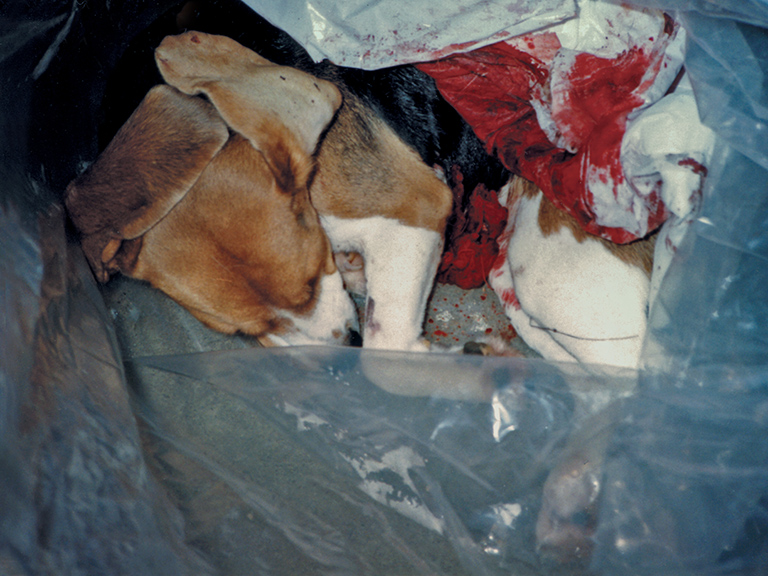
2005HLS Whistleblowers. Two HLS Beagle Unit workers leave their jobs distressed over suffering observed for 12 months. In recorded affidavits they describe: Overdosed animals kept secret by staff; dogs scarcely anesthetized for painful bone marrow extraction from the chest bone; needle jab contests; blood transferred into the wrong tubes; nothing noted, no one told. A coworker “would go in and out five times with the same needle, not hitting a vein. I saw others grab dogs by the scruff, shout and swear, swing them and slap them… If you forgot to write a time you were told to make one up. This is falsifying data.”
Team leaders hadn't given the dog enough anesthetic [on kill day]. The dog whimpered and moved. They didn't give more… I was always told not to cry, the dogs were bred for a purpose. Now they had to go.
Former Beagle Unit WorkersHuntingdon Life Sciences
2007 – 2009Monkey Hell. Animal Defenders International tracks the primate research trade across South America and Asia to HLS in Cambridgeshire. An ADI/NAVS (Nat'l Anti-Vivisection Society) investigator, hired as an animal tech for HLS primate toxicology units, witnesses: Monkeys thrash while cinched in chairs for inhalation of toxins. Some suffer rectal prolapse. Three monkeys die in agony from collapsed or obstructed lungs. In the wild, cynomolgus macaques occupy trees in groups of 50-100 animals. They are smart, sensitive animals. An HLS record describes one monkey who “would cry” when caged “because he wanted to spend a little more time outside, held or groomed by the attending physician.” (Abney, D. et al 2006. Human-animal relationship in the research lab: a discussion by the refinement and enrichment forum. Animal Technology and Welfare. Aug, pp.95-98) Investigator logs reveal bleak, metal cells, devoid of sunlight and enrichment stimuli. Primates self-mutilate to cope. One gnaws off an entire finger. Another shreds her face and must eat via feeding tube. A monkey used in diabetes drug tests is found with a bloody face. The animal's toe tips are gone, prompting HLS techs to believe he'd gnawed them off himself. But the investigator observes straight-slash wounds that suggest the monkey's foot was wedged in sharp cage slats and severed to break free.
HLS lets clients choose from dogs, monkeys, mini-pigs, cats, rodents, guinea pigs, rabbits, goats and even horses. The Beagle Unit can restrain 2,500 dogs; the primate unit, up to 550 monkeys. During the investigator's stint, nearly 217 monkeys are killed for just five studies. “On the day of the necropsies, the monkeys are silent. The normal shrieking, chatter and rattle of cages falls to an eery silence. The magnitude of the monkeys’ awareness of the nightmare they face cannot be clearer.“ (Save the Primates Investigation. ADI/NAVS Primate Testing In Europe. 21 Contemporaneous Notes 06; Investigator, laboratory questionnaire 08.)
2010Bred To Die. The chain of violence begins with breeders that produce animals for labs. At Primate Products Inc. (Miami, FL) an Animal Liberation Investigation Unit films near-dead monkeys with bloody scalps. Their wounds are so deep, tissue is exposed. ALF shares PPI records with Stop Huntingdon Animal Cruelty (SHAC-UK), including HLS purchase orders for hundreds of monkeys in China. What happens to animals bred to die? Monkeys in labs are strapped into chair-restraint devices. Their anxiety is intense; many suffer rectal prolapse (the rectum detaches and telescopes out through the anus, inside out). During an HLS probe, three cinched monkeys dosed on an incontinence drug have rectal prolapse. A fourth monkey has recurring prolapses in another experiment.
At HLS animals are poisoned via nasal-gastric tube (oral gavage), forced inhalation, or injection. To tube a small monkey, “the ‘catcher’ pins the animal's arms, the ‘legger’ takes the legs, and another feeds a rubber tube down the throat to the animal's stomach to pump in test substances.” In one HLS oral dosing experiment, monkeys incessantly vomit and hyper-salivate. Some leak black urine on cage floors. A sick and terrified monkey chews off most of a finger. Other poisoned monkeys “tug at chest skin, push fists into their mouths, try to bite through the metal food hopper, push sawdust into cheek pouches, chew metal and drag teeth along cage bars.” During a HLS inhalation experiment, three monkeys with collapsed or obstructed lungs die or are killed. Three more partially collapsed monkeys are resuscitated to finish experiments. When killed, post-mortem exams reveal blackened lungs. (The Experiments. Huntingdon Life Sciences Investigation. 1/22/13)
2012 – 2016Beagle Liberation. Italian animal liberationists seize 40 dogs in a daylight raid of Green Hill, a research breeder in Montichiari Italy that supplies animals to Huntingdon Life Sciences. Owned by U.S. company Marshall BioResources in North Rose, NY, Green Hill customizes dogs with severed vocal chords, to erase their barks and cries inside labs. Mid-summer the same year, 2500 more Green Hill beagles win freedom when an Italian court shutters the facility amid allegations of animal abuse. In a cruelty complaint filed by Lega Anti Vivisezione, three executives are convicted on animal abuse charges. The dogs go to rescue under a mandate that animal rights groups care for them. Still, in 2012 Green Hill does not legally close. Marshall Farms files appeals to overturn the order and reopen. By 2016, evolving animal welare laws in Italy finally force Green Hill — and its sister site Yorkshire Beagles — out of business. (Cruelty Free International. Italian Beagle Breeding Farm Closes. 12/16/16)
Where Is Huntingdon Life Sciences Today? Absorbed into a power nexus so thick, one is hard-pressed to find them. A HLS Map Quest lands upon the old site at 100 Mettlers Rd; Somerset, NJ 08873; 732-873-0063. A website URL for envigo.com detours to Inotiv. The story that ends with Inotiv — a consortium of animal research “products and services” — goes something like this:
1951 › Huntingdon Life Sciences begins in Cambridgeshire, England and matures into the world's leading contract research lab with headquarters in the U.K. and New Jersey, USA.
1961 › Harlan Industries incorporates as a leader in animal models for laboratory research.
1974 to 1989 › Harlan expands, cementing its brand as vivisection kingpin. In 1974 Bioanalytical Systems (BASi) forms in West Lafayette, IN. In 1979 Harlan acquires Biotrol, now called Envigo Bioproducts, and buys Spartan Research Animals in Haslett, MI. In 1980, GIBCO Animal Research Labs is attained. Harlan renames to Harlan Sprague Dawley, Inc. in 1981 and buys M.A. Laboratory Animals (Walkersville, MD). The rest of the 1980s mark more acquisitions: TIMCO Breeding Laboratories (Houston, TX); Engle Laboratory Animals (Farmersburg, IN); Laboratory Supply Company, Inc. (Indianapolis, IN). In 1985 Harlan Bioproducts for Science takes root in Indiana. Then the company goes global with OLAC Limited of Oxfordshire, England. Harlan picks up: Southern Animal Farms (Prattville, AL); The Holtzman Company (a Madison, WI producer of albino rats); Central Institute for Breeding of Laboratory Animals (a Netherlands buyout that adds large animals to Harlan's catalog); Blue Spruce Farms (Altamont, NY); Porcellus Animal Breeding Limited (Heathfield, England, “for a supply of guinea pigs”); Riom Laboratories-CERM (Riom France, to “introduce rabbit production in the UK and a second canine colony in France”); Premier Laboratory Diets (Bartonville, IL); Twin City Testing; Kansas City Southwestern; Empire Soils; Applied Biosciences International.
1990 to 1999 › With Harlan's buyout of HLS still on the horizon, the 1990s bring yet more acquirements: New maximum-barrier lab animal facility (Houston, TX); Dominion labs (Dublin, VA); global ops in Germany, and Italy, plus Israel's Weizmann Institute, where a former lab tech's testimony reveals brain experiments that carve holes into the skulls of monkeys and cats. Harlan gains over “240 stocks and strains including mice, rats, hamsters” with acquisitions from Hannover Institute (Germany) and TNO-REPGO Institute (Rijswijk, the Netherlands). From 1995 to 1999, Harlan gets: Interfauna Group (UK, Germany, Spain); Sera-Lab (UK); Toxic Pathology Services Inc. (Evansville, IN). Harlan Bioservice for Science forms in Walsrode, Germany.
2004 to 2013 › With its takeover of RCC Ltd. (Switzerland) Harlan commands European and Asian vivisection markets for pharma, chemical and agrochemical industries. In 2007, Harlan gets SafePharm Laboratories (Shardlow, UK). By 2008 the giant rebrands itself as Harlan Laboratories Inc. That same year, Huntingdon Life Sciences transitions to private ownership, with an inner loop of shareholders whose stock has no IPO and cannot trade on public exchanges.
2015 › Harlan Laboratories and Huntingdon Life Sciences merge to create the Envigo brand. In an earlier merger, HLS renamed itself Life Sciences Research Inc. On 9/21/15 Envigo Opens Its Doors For Business, under the newly consolidated Huntingdon Life Sciences and Harlan Labs, with subsidiaries GFA, NDA Analytics and LSR associates. Brian Cass, then HLS CEO and one-time target of SHAC-UK/US before government suppression lands animal rights protesters in jail, says: “We are delighted to officially re-brand as Envigo.” Envigo has 3,800 employees with sales at nearly $500M.
2018 to 2021 › In 2018 BASi and Seventh Wave join forces. Envigo secures Horizon (formerly SAGE Labs Inc.) in 2019, and gains genetically engineered models such as the knockout rat, knockin rat, six-month KO mouse and conditional KO rat. BASi/Seventh Wave gets Smithers Avanza Toxicology Services (Gaithersburg, MD), with a GLP lab for toxicology, vaccines, and developmental/reproductive animal research. Then BASi rebrands as Inotiv. From 2019-2021, Inotiv acquires: PreClinical Research Services (Ft. Collins, CO); HistoTox Labs; Bolder BioPATH (Boulder, CO); MilliporeSigma BioReliance® assets; Gateway Pharmacology Laboratories; Plato BioPharma (a Colorado in vivo pharma lab focused in cardiovascular, renal, pulmonary and hepatic animal experiments).
2021 › Inotiv acquires Envigo, and along with it, Huntingdon Life Sciences. Headquartered in West Lafayette, IN, Inotiv is a CRO (Contract Research Organization) that breeds/sells animals to labs and conducts experiments for the pharma, biotech, government and academic sectors. Since formed in 2018, Inotiv has faced ongoing probes related to animal mistreatment. We're fairly certain of two projections: Inotiv shows reckless disregard for animals as it seeks dominance across the bioresearch industry. Huntingdon Life Sciences still torments animals for non-predictive, misleading research that can be replaced with human-focused tools relevant to people.
2023 › Inotiv is interrogated for illegal import of Asian monkeys. U.S. prosecutors charge employees of an Inotiv supplier with criminal “conspiracy and smuggling of endangered long-tailed macaques from Cambodia” into the U.S., as reported in The Wall Street Journal and other media outlets. The U.S. Securities and Exchange Commission gathers evidence to assess whether Inotiv and its subsidiaries violated the Foreign Corrupt Practices Act. Long-tailed macaques are an endangered species under international treaty protection. To compensate for its lack of breeding monkeys, the Inotiv supplier reportedly paid Cambodian officials to issue counterfeit permits that classify wild-caught monkeys as captive-bred. Prosecutors in Florida say that co-conspirators illegally purchased macaques via black-market sources from Dec 2017 to Jan 2022, with 2023 litigation still pending in 2024.
2024 › Envigo is barred from breeding or selling dogs. Parent company Inotiv on watch after big payouts. 6/3/24: Inotiv pays over $35 million in penalties for Animal Welfare Act and Clean Water Act infractions, the highest fine ever accrued in an animal welfare case. The deal and guilty plea in U.S. Federal Court for the Western District of Virginia bring resolution to a May 2022 Justice Department probe of Envigo RMS's Cumberland, VA compound. At the time, officers armed with a criminal search warrant raided Envigo — once a top breeder of beagles for research that merged with HLS in 2015 — and seized 4,000 dogs from abuse and squalor. In 2024, Envigo pleads guilty to willfully conspiring to violate the Animal Welfare Act. The DOJ lawsuit asserts heinous violations. USDA inspectors uncover deficient veterinary care, incompetent staffing, and failure to comply with AWA rules for how to handle, shelter, feed, hydrate and hygienize animals. Violations recorded over the multiyear inquest include:
- Dogs with treatable injuries and ailments are instead destroyed.
- Envigo kills dogs without anesthesia, some by a poison-loaded injection directly into the heart. Heart stick euthanasia is so cruel, many want to see it outlawed.
- Envigo neglects to record how or why hundreds of puppies die.
- Mothers nursing their pups are underfed or starved.
- Over 500 puppies and adults housed in a building without air conditioning suffer “discomfort, lethargy or stress” in temps above 85 degrees.
- Food defiled by maggots, mold and feces is fed to dogs.
- Kennels are overfull, with little space to move. Dogs are wounded, their paws trapped in metal-slat floors.
- Envigo declines to fire veterinarian “AV” amid ongoing staff complaints about reckless handling, such as botched surgeries on five dogs (Reuters).
As of this writing, Envigo's formal sentencing is set for 10/7/24. Corporate parent Inotiv consents to pay $3 million to humane groups, such as Humane Society of the U.S. ($1.9 million) that assist on site and help re-home dogs via shelters across nearly 30 states. Another $3.5 million is paid to compensate for canine waste contamination in Cumberland waterways. Inotiv must also invest $7 million to align its subpar facilities with federal animal welfare law. Read more about the case that takes down Envigo and surveils Inotiv.


